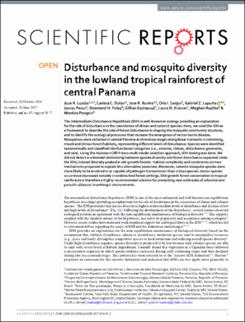| dc.contributor.author | Loaiza, Jose R. | |
| dc.contributor.author | Dutar, Larissa C. | |
| dc.contributor.author | Rovira, Jose R. | |
| dc.contributor.author | Sanjur, Oris I. | |
| dc.contributor.author | Laporta, Gabriel Z. | |
| dc.contributor.author | Peco, James | |
| dc.contributor.author | Foley, Desmond H. | |
| dc.contributor.author | Eastwood, Gillian | |
| dc.contributor.author | Kramer, Laura D. | |
| dc.contributor.author | Radtke, Meghan | |
| dc.contributor.author | Pongsiri, Montira | |
| dc.date.accessioned | 2020-07-04T08:21:22Z | |
| dc.date.available | 2020-07-04T08:21:22Z | |
| dc.date.issued | 2017-08-03 | |
| dc.identifier.other | https://doi.org/10.1038/s41598-017-07476-2 | |
| dc.identifier.uri | http://repositorio-indicasat.org.pa/handle/123456789/173 | |
| dc.description | The Intermediate Disturbance Hypothesis (IDH) is well-known in ecology providing an explanation for the role of disturbance in the coexistence of climax and colonist species. Here, we used the IDH as a framework to describe the role of forest disturbance in shaping the mosquito community structure, and to identify the ecological processes that increase the emergence of vector-borne disease. Mosquitoes were collected in central Panama at immature stages along linear transects in colonising, mixed and climax forest habitats, representing diferent levels of disturbance. Species were identifed taxonomically and classifed into functional categories (i.e., colonist, climax, disturbance-generalist, and rare). Using the Huisman-Olf-Fresco multi-model selection approach, IDH testing was done. We did not detect a unimodal relationship between species diversity and forest disturbance expected under the IDH; instead diversity peaked in old-growth forests. Habitat complexity and constraints are two mechanisms proposed to explain this alternative postulate. Moreover, colonist mosquito species were more likely to be involved in or capable of pathogen transmission than climax species. Vector species occurrence decreased notably in undisturbed forest settings. Old-growth forest conservation in tropical rainforests is therefore a highly-recommended solution for preventing new outbreaks of arboviral and parasitic diseases in anthropic environments. | en_US |
| dc.description.abstract | The Intermediate Disturbance Hypothesis (IDH) is well-known in ecology providing an explanation for the role of disturbance in the coexistence of climax and colonist species. Here, we used the IDH as a framework to describe the role of forest disturbance in shaping the mosquito community structure, and to identify the ecological processes that increase the emergence of vector-borne disease. Mosquitoes were collected in central Panama at immature stages along linear transects in colonising, mixed and climax forest habitats, representing diferent levels of disturbance. Species were identifed taxonomically and classifed into functional categories (i.e., colonist, climax, disturbance-generalist, and rare). Using the Huisman-Olf-Fresco multi-model selection approach, IDH testing was done. We did not detect a unimodal relationship between species diversity and forest disturbance expected under the IDH; instead diversity peaked in old-growth forests. Habitat complexity and constraints are two mechanisms proposed to explain this alternative postulate. Moreover, colonist mosquito species were more likely to be involved in or capable of pathogen transmission than climax species. Vector species occurrence decreased notably in undisturbed forest settings. Old-growth forest conservation in tropical rainforests is therefore a highly-recommended solution for preventing new outbreaks of arboviral and parasitic diseases in anthropic environments. | en_US |
| dc.language.iso | eng | en_US |
| dc.rights | info:eu-repo/semantics/openAccess | |
| dc.rights | http://creativecommons.org/licenses/by/4.0/. | |
| dc.subject | Disturbance and mosquito diversity | en_US |
| dc.subject | lowland tropical rainforest | en_US |
| dc.subject | Panama | en_US |
| dc.subject | central | en_US |
| dc.title | Disturbance and mosquito diversity in the lowland tropical rainforest of central Panama | en_US |
| dc.type | info:eu-repo/semantics/article | en_US |
| dc.type | info:eu-repo/semantics/publishedVersion | |

